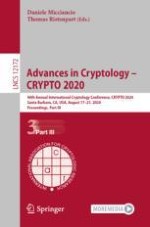2020 | OriginalPaper | Buchkapitel
Non-malleable Secret Sharing Against Bounded Joint-Tampering Attacks in the Plain Model
verfasst von : Gianluca Brian, Antonio Faonio, Maciej Obremski, Mark Simkin, Daniele Venturi
Erschienen in: Advances in Cryptology – CRYPTO 2020
Aktivieren Sie unsere intelligente Suche, um passende Fachinhalte oder Patente zu finden.
Wählen Sie Textabschnitte aus um mit Künstlicher Intelligenz passenden Patente zu finden. powered by
Markieren Sie Textabschnitte, um KI-gestützt weitere passende Inhalte zu finden. powered by
Abstract
-
A secret sharing scheme for threshold access structures which tolerates joint \(p\)-time tampering with subsets of the shares of maximal size (i.e., matching the privacy threshold of the scheme). This holds in a model where the attacker commits to a partition of the shares into non-overlapping subsets, and keeps tampering jointly with the shares within such a partition (so-called selective partitioning).
-
A secret sharing scheme for general access structures which tolerates joint \(p\)-time tampering with subsets of the shares of size \(O(\sqrt{\log n})\), where \(n\) is the number of parties. This holds in a stronger model where the attacker is allowed to adaptively change the partition within each tampering query, under the restriction that once a subset of the shares has been tampered with jointly, that subset is always either tampered jointly or not modified by other tampering queries (so-called semi-adaptive partitioning).
